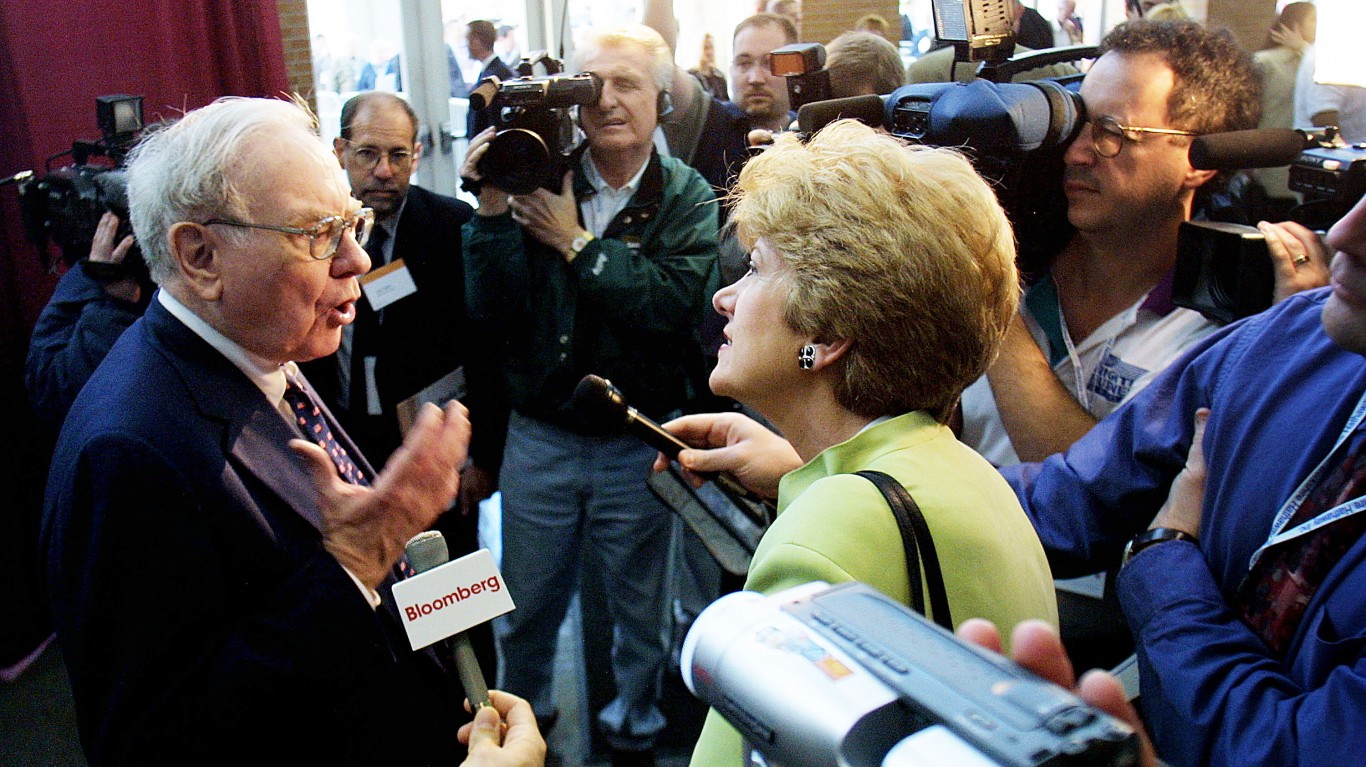 It’s no secret that many jobs traditionally have been dominated by one gender or another. While the inroads women are making into traditionally male-dominated jobs have been much discussed, it appears that men are making similar inroads into jobs once completely dominated by women.
It’s no secret that many jobs traditionally have been dominated by one gender or another. While the inroads women are making into traditionally male-dominated jobs have been much discussed, it appears that men are making similar inroads into jobs once completely dominated by women.
Read: The Pink Collar Jobs America’s Men Want Most
24/7 Wall St. investigated the increasing numbers of men turning to jobs that are — still — much more often held by women. We looked at change in male participation between 2000 and 2011 among jobs that employ at least 75% women to identify the professions where the proportion of men has increased the most. While no one factor can explain the increased male presence in these female-dominated jobs, a sluggish economy, new opportunities and changing gender roles contribute to the change.
According to several reports on the subject, as well as numerous interviews we conducted, men often take to these roles due to economic necessity. In a weak economy, people are more likely to pursue jobs they otherwise would not consider. Discussing clerk and teller jobs — a pink-collar occupation — Carol Kaplan, the media contact for the American Bankers Association, explained that these are typically part-time positions dominated by women, but that men could be increasingly entering these positions because they are unemployed and can find no other work.
Most of the so-called pink-collar jobs we reviewed are part-time ones. As many as 62% of dental hygienists and clerical library assistants work part time. This is because, traditionally, it was more common for women to assume greater domestic responsibility, and part-time roles offered them some flexibility. According to interviews we conducted, the part-time nature of these jobs also means they have a higher turnover rate than other occupations, making them more accessible to men looking for work as a result of the economic downturn.
All of the female-dominated jobs in which men have made the greatest inroads require less than a four-year college degree. Dental hygienists and paralegals must have a minimum of an associate degree, while only some high school education is necessary for personal care aide and clerical library assistant jobs. The lack of high-level requirements for many of these occupations means men looking for work are more easily able to step into these positions than some other roles.
Also Read: Ten Brands That Will Disappear In 2013
24/7 Wall St. identified the number of people employed in each of the occupations listed in the Current Population Survey, a joint venture by the U.S. Bureau of Labor Statistics and the U.S. Census Bureau. The survey measured the number of people employed in more than 500 jobs and the proportion occupied by men and women. We started with occupations that were at least 75% women-occupied in 2000 and looked at those that had the greatest increase in the proportion of men. 24/7 also used BLS data to determine the change in the number of people employed in these positions, the general job description and the 2011 median hourly wage. We contacted professional organizations from each occupation to get their opinions on the changing job environment.
These are the nine pink-collar jobs America’s men want most.
9. Paralegals and Legal Assistants
> Pct. increase in male participation: 32.3%
> Pct. male in 2000: 11.8%
> Pct. male in 2011: 15.6%
> Median hourly income: $22.47
From 2000 to 2011, there was a 32.3% proportional increase in male participation in paralegal and legal assistant jobs. The median hourly income for paralegal and legal assistants of $22.47 annually is well above the national average of $16.57. Over the past decade, the number of positions has increased by about 44%. These job options are great for people interested in law and who want to enter the field with just an associate’s degree rather than becoming a lawyer, which requires at least a doctoral or professional degree.
8. Receptionists and Information Clerks
> Pct. increase in male participation: 32.8%
> Pct. male in 2000: 6%
> Pct. male in 2011: 7.9%
> Median hourly income: $12.35
Receptionists perform a variety of administrative tasks, such as handling phone calls and documenting and recording maintenance. Unlike many jobs, for which new positions are scarce, the BLS projects a 24% increase in the number of receptionist and information clerk hires between 2010 and 2020. According to Emily Allen, Manager of Communications and Publications for the International Association of Administrative Professionals, the nearly one-third increase in men taking up this position has much to do with economic necessity. She also explains that gender roles appear to be changing: “Men with college degrees are filling these roles by choice, finding challenge in a profession that has changed significantly in recent years.”
7. Insurance Claims and Policy Processing Clerks
> Pct. increase in male participation: 36%
> Pct. male in 2000: 12.6%
> Pct. male in 2011: 17.1%
> Median hourly income: $16.93
Insurance claims and policy processing clerks handle new insurance policies and make modifications to existing policies and claim forms. In 2000, only 12.6% of these positions were held by men. More than a decade later, this proportion has increased to 17.1%. Insurance claims clerks have median annual salary of $35,210, and the highest educational degree typically required is a high school diploma. According to the BLS, the number of such clerks is expected to grow 9% between 2010 and 2020.
6. Personal Care Aides
> Pct. increase in male participation: 39.9%
> Pct. male in 2000: 10.3%
> Pct. male in 2011: 14.5%
> Median hourly income: $9.49
Personal caretakers have a median annual income of just under $20,000, and they assist the elderly and persons with disabilities in their daily lives at home or in a facility. The job requires less than a high school education, which means more people looking for work are eligible. Demand for these jobs is increasing, as the population requiring such services continues to grow. The high turnover rate in caretaking jobs creates many opportunities for men to enter the profession.
5. Licensed Practical and Licensed Vocational Nurses
> Pct. increase in male participation: 48.4%
> Pct. male in 2000: 6.5%
> Pct. male in 2011: 9.6%
> Median hourly income: $19.79
Licensed nurses provide basic nursing care and take direction from both registered nurses and doctors. Their duties include checking blood pressure, changing bandages and maintaining patient health records. The BLS projects a 22% increase in the number of licensed practical and vocational nurses from 2010 through 2020. The median hourly wage of $19.79 is more than $3 higher than the national median, and the median annual wage is $41,150. In 2000, just 6.5% of licensed nurses were men. From 2010 to 2011, the number of licensed nurses fell by around 13,000, while the number of men working in the position rose by about 5,000.
Also Read: Eight States Slashing Local Funding
4. Library Assistants, Clerical
> Pct. increase in male participation: 53.3%
> Pct. male in 2000: 12.1%
> Pct. male in 2011: 18.6%
> Median hourly income: $11.27
Standard tasks for those who work as clerical library assistants include compiling records and organizing the library’s catalog, as well as issuing and receiving materials. Clerical assistants are likely to be familiar with the use of catalogs, databases, spreadsheets and document management software. While the position as a whole has declined in popularity, the number of men working as clerical assistants in libraries has increased from 15,000 to 21,000.
3. Loan Interviewers and Clerks
> Pct. increase in male participation: 63.9%
> Pct. male in 2000: 10.9%
> Pct. male in 2011: 17.9%
> Median hourly income: $16.74
Most loan interviewer and clerk jobs require interviewing loan applicants, investigating backgrounds, verifying references and preparing loan request forms. Carol Kaplan, media contact for the American Bankers Association, speculates that “traditionally, clerk and teller jobs are part-time positions, which are typically dominated by women who have caretaking responsibilities.” However, from 2000 to 2011, the number of men working in such jobs increased by 63.9%. In 2000, men made up just 10.9% of loan interviewers and clerks. Kaplan suggests that the economic downturn may have forced men into these roles.
2. Word Processors and Typists
> Pct. increase in male participation: 71.2%
> Pct. male in 2000: 6.4%
> Pct. male in 2011: 11%
> Median hourly income: $16.47
Word processors and typists are responsible for typing documents, checking grammar and spelling, as well as other clerical duties. The median annual wage is $34,260, according to the BLS. Word processor and typist professions decreased by almost 65% from 2000 to 2011, the 10th-fastest declining occupation in the United States, also according to the BLS.
Also Read: Eight Things To Do If You Haven’t Planned for Retirement
1. Dental Hygienists
> Pct. increase in male participation: 197.3%
> Pct. male in 2000: 0.9%
> Pct. male in 2011: 2.7%
> Median hourly income: $33.31
As a career option, becoming a dental hygienist is rapidly gaining popularity. The field has strong growth prospects, with the BLS anticipating 38% more job opportunities in 2020 than 2010 — far faster growth than most careers. The appeal of these jobs is evident: the median pay in 2011 was more than $69,000 a year, the hours are highly flexible, and the position requires only an associates degree. In 2000, less than 1% of dental hygienists were men. By 2011, however, male participation had increased to 2.7% of all hygienists, representing a 197.3% rise in the number of men pursuing this career. With almost 150,000 dental hygienists in the U.S., even small increases in the proportion of men in these roles represent significant changes in the number of men employed.
-By Michael B. Sauter, Lisa A. Nelson and Alexander E.M. Hess
It’s Your Money, Your Future—Own It (sponsor)
Are you ahead, or behind on retirement? For families with more than $500,000 saved for retirement, finding a financial advisor who puts your interest first can be the difference, and today it’s easier than ever. SmartAsset’s free tool matches you with up to three fiduciary financial advisors who serve your area in minutes. Each advisor has been carefully vetted and must act in your best interests. Start your search now.
If you’ve saved and built a substantial nest egg for you and your family, don’t delay; get started right here and help your retirement dreams become a retirement reality.
Thank you for reading! Have some feedback for us?
Contact the 24/7 Wall St. editorial team.





